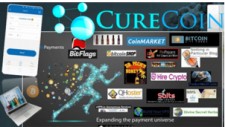Bio Research Loves Curecoin: Gamers and Speculators to Overtake #1 Team

SAN FRANCISCO, August 25, 2017 (Newswire.com) - The CureCoin Team, a group participating and competing within a Stanford project, announced that the CureCoin (CURE) network is poised to overtake the folding@evga team in cumulative points on or about Aug. 29, 2017. CURE, only 39 months old, is taking the #1 position after 17 years of FAH history with hundreds of teams participating globally. The CURE network enabled a way to finance scientific research without grant applications. The team uses computers to simulate protein folding, and it is partially sponsored by investors hoping for profit. It awards CURE tokens to people who use their computers to do protein folding simulations, computational drug design, and modeling of other types of molecular dynamics for Stanford’s Folding@Home research program. Anyone with a computer and internet access can join the Curecoin team.
Stanford University’s Folding@Home (FAH) is a distributed computing network and the protein folding takes place on thousands of computers located in people’s homes, offices, and on Amazon Web Services as well as Google servers. Computers with graphics processing units (GPUs) do the heavy lifting of the protein simulations. Windows, Apple and Linux operating systems, including Android, are used. The most powerful hardware components are high-end graphics cards, which are mainly found on modern gaming computers.
We are always excited to see newcomers to the Folding@Home project, especially if they choose the Curecoin team. Thank you for helping us to become the #1 team in cumulative points.
Josh Smith, Founding CureCoin Developer
The FAH research project has resulted in 139 academic papers on topics such as various cancers, Alzheimer’s, Parkinson's, ALS, HIV, and many other deadly infectious diseases, along with improvements within the field of computational biology. Results are sometimes helpful in the development of pharmaceuticals.
Curecoin is important as an incentive to do this computational work. By awarding CureCoins, this compensation helps offset participants’ electricity and equipment costs. If held for longer periods, the CURE tokens received may become more valuable than the resources spent producing the protein simulations. The CURE team currently has over 1,000 active participants and produces approximately 40% of the FAH 72,000 teraflops of computational research. In addition to CURE, another token, FoldingCoin, has been an important ally in helping CURE to achieve the #1 position, and this additional virtual currency is available optionally to members of the CureCoin team if the username is set up properly.
To put things into perspective for the amount of work produced, it would take roughly 100,000 two-year old laptops, or 54,000 two-year old iMacs, or 890 gaming PCs with one new high-end GPU each.
Since Stanford estimates the difficulty of the work units that are assigned, and the CureCoin network issues its tokens based on how many points are awarded by Stanford for the completed work units to individuals on the CureCoin team, the process is considered fair.
So what exactly is CureCoin?
CureCoin (CURE) is a virtual currency similar to Bitcoin that may be spent with anyone who accepts it as payment, including a person with almost any computer, and over 310,000 vendors in 182 countries, through a service at Coinpayments.net. CURE has a value that is expressed in Bitcoin, and is traded on exchanges. Since Bitcoin is traded in markets and is expressed in national currencies such as the U.S. dollar, CURE has a value that fluctuates versus the dollar. Like Bitcoin, its total issuance is mathematically limited over time. CURE is considered to be a gateway to other digital currencies since the FAH software is so easy to download and use, and because of the general agreement that research in biology is good for society. It may also become of interest to educators wishing to teach about blockchains in computer science.
Investors and speculators buy CureCoins hoping that it will become a more important currency for charitable contributions, and for facilitating payments to and within the health field. The thought of charging pharmaceutical research companies for computing effort in CURE has also been discussed lightly, but it would be a long-term effort that has not begun in earnest yet. There are legal, organizational, and technical concerns to overcome before this could become a reality.
For more information about CureCoins, please go to https://curecoin.net or contact info@curecoin.net.
Source: CureCoin